West Ham had a poor first half of the season under Manuel Pellegrini, where they only secured two wins in all competitions from late September to December. The Chilean was sacked after the loss against Leicester City, with David Moyes making a triumphant return to the Hammers.
Under the Scott, West Ham recorded two wins, two draws and four loss in their last eight games. The victories were from the first two games, against Bournemouth and Gillingham in the FA Cup. Now, in the Premier League, after 26 games, they are in the relegation zone, a point behind Aston Villa.
Recalling the ambitious signings in the summer, certainly West Ham’s position does not match the investments made. Two of their top three most valuable arrivals, Sébastian Haller (€40m) and Pablo Fornals (€28m) were made last summer and are yet to really deliver. The defensive issues had long been an issue and Pellegrini was unable to tackle it, so the Chilean’s departure was inevitable.
From a tactical point of view, the pressing of West Ham was one of their most urgent issues which had to be solved, as soon as possible. In this tactical analysis scout report, we will show you the pressing inefficiency of Moyes’ West Ham. It is an analysis that focuses on Moyes’ tactics.
PPDA & Compactness
Two seasons ago, in the 2017/18 campaign, Moyes once became the manager of West Ham. There are players he should be familiar with. Some of the key players are defenders Angelo Ogbonna, Aaron Cresswell, and Declan Rice. Captain Mark Noble and offensive players like Manuel Lanzini and Robert Snodgrass also trained with Moyes before.
To briefly sum up the problem, the major issue at West Ham was their pressing. It was the compactness which was complex as it consisted of collective and individual issues. We will break down these issues in the coming sections.
First, we will summarize the PPDA of West Ham over the last one month. As it reflected in the line graph below, it seemed their pressing intensity fluctuated a lot. However, if we exclude the game against Liverpool, West Ham’s PPDA ranged from 6.3 to 16.52.
However, their pressing efforts were not rewarded when we further dig into the statistics. In these games, only West Brom’s 0.76 xG was lower than one. For Sheffield United, Everton and Brighton, their xG was all over two (2.31; 2.19; 2.49), let alone Leicester and Liverpool.
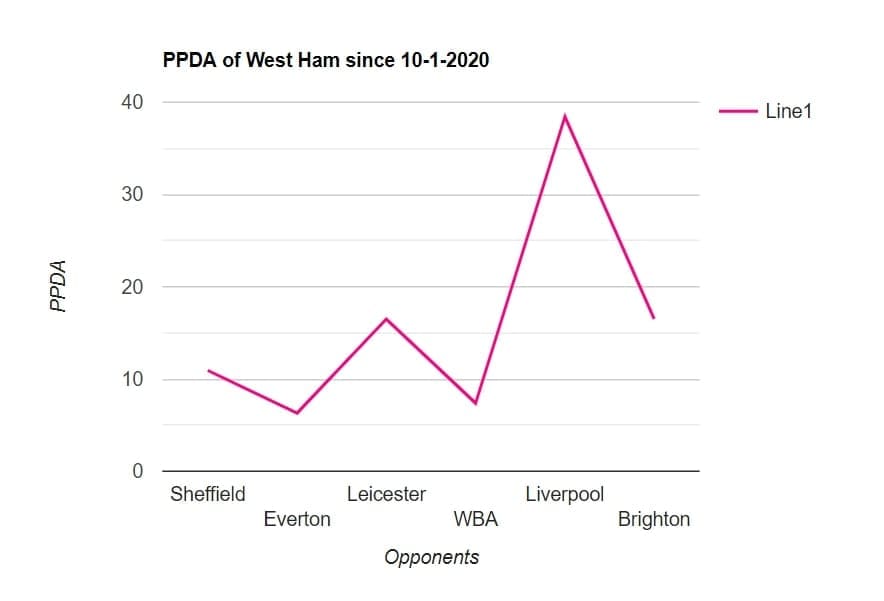
Before our analysis, let us think: why do a team press?
The press is meaningless if they did not serve any defensive purposes. The objectives could be delaying attacks, disrupting the build-ups, or even denying an individual to receive the ball. But, what makes a good pressing tactic?
The followings are not dogmas, but usually, successful pressing share some features:
- Compactness
- Unanimous defensive actions (defending as a unit)
- Sufficient energy and intensity
West Ham were missing these.
Spaces within the block
Almost all these issues can be concluded to the fact that the team was not compact enough when defending. To further explain, it means the distances between the defensive lines or players were too large. Their opponents were exploiting these spaces to begin their attack.
West Ham had troubles to prevent the central midfielders from receiving the ball against team moving the ball with a double-pivot. Everton, Brighton, West Brom, and Sheffield United all played with two midfielders.
The point was the two midfielders of the Hammers seldom follow up to support the front players. In the FA Cup loss against West Brom, Moyes played Carlos Sánchez and Rice at the midfield and Haller and Albian Ajeti at front.
As we clearly see in the below image. The distances between these four players was too big, hence, it made their block bigger and Gareth Barry enjoyed plenty of space to carry the ball.
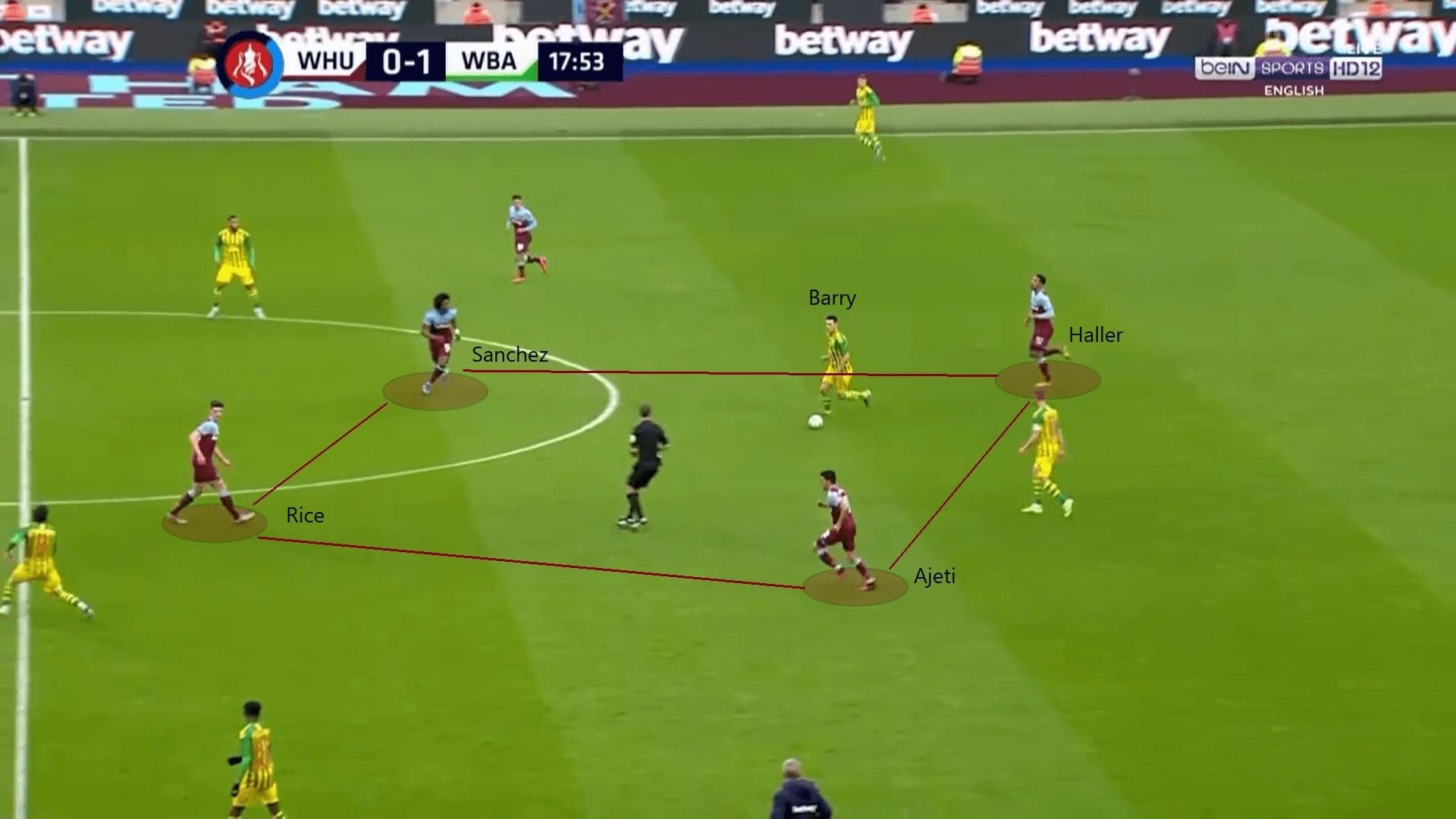
Below was another example from the Brighton draw. This time, the block was formed by the striker (Haller), wingers (Snodgrass & Michail Antonio) and a midfielder (Tomáš Souček), as they were playing in a 4-1-4-1 formation.
However, the issue remains the same, as these four players are too far apart. Again, Brighton were playing out from the back with a double-pivot, hence, Souček was overloaded by two players (Davy Pröpper & Dale Stephens).
In this scenario, Pröpper positioned himself within the block, received and progressed the ball comfortably as he exploited the large spaces between the players.
These examples concluded how teams bypassed the pressing of West Ham by exploiting the spaces within the block. The pivot could just simply carry the ball between the players.
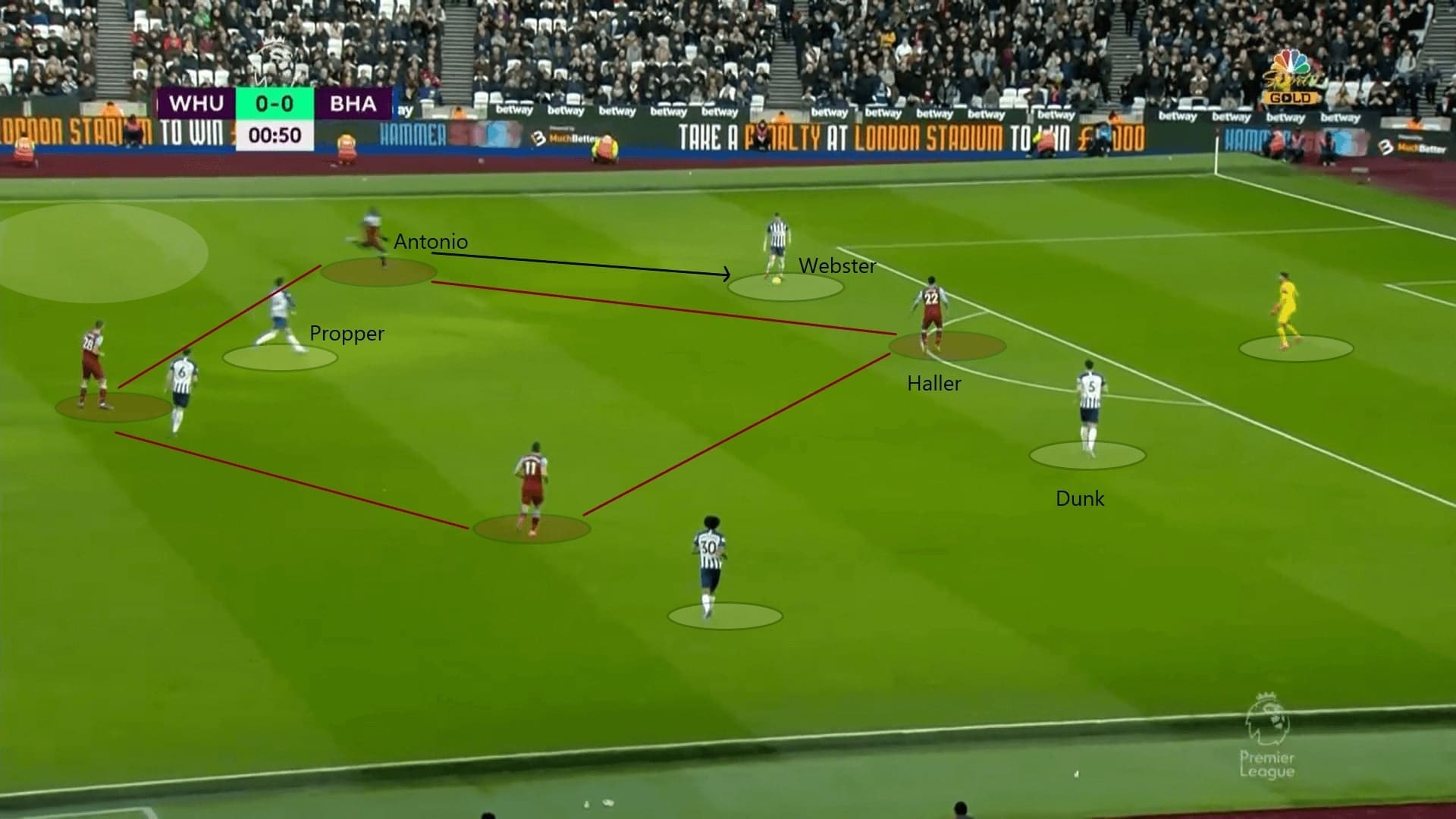
What triggered the press?
They were unclear on what the triggers were and who was going to step out and pressure the ball. In past interviews and demonstrating training sessions Moyes emphasized the importance of pressing and the rules he incorporates. Usually, it was the player closest to the ball lead the line to press. However, on the pitch, it seemed the players were yet to fully understand the requirements and moments of pressing.
This is a defensive action example. West Ham and Leicester reached numerical equality. When Jonny Evans holds the ball, Antonio stepped out to press him. However, neither Noble nor Haller follow up to press. As a result, Evans carried the ball to the huge spaces on the flank, as no one was compressing the wide areas.
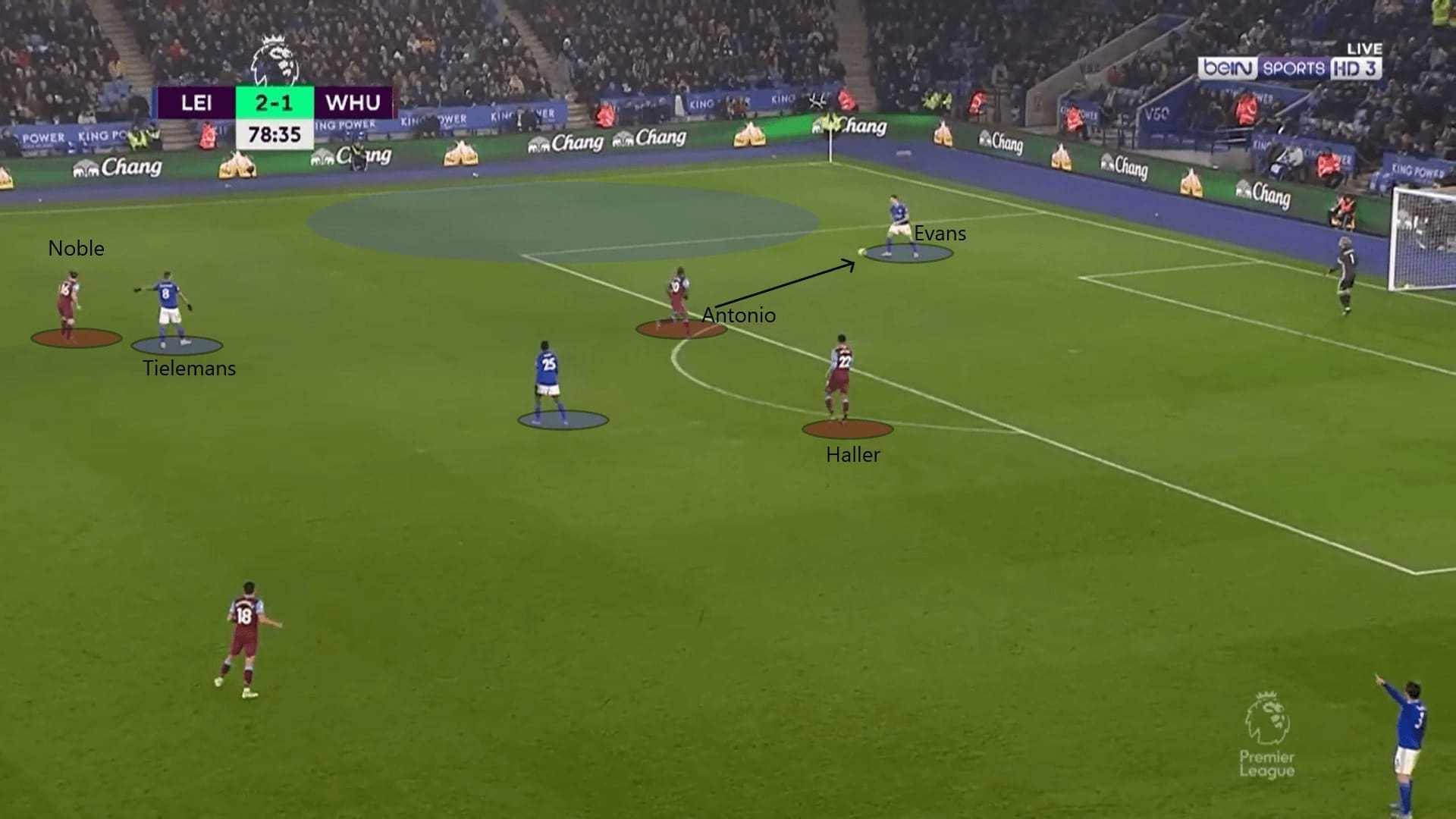
There was another problem in their pressing. When the ball was played to the wide areas, usually, the wide players stepped out to pressure the receiver. However, the central players were not doing enough to block or intercept the return pass. These made the efforts of the pressing players useless.
In this example, Chris Basham passed the ball to John Lundstram. Arthur Masuaku came from behind and did not allow the 25-year-old to turn. Lundstram did not have many options, and he returned the ball back to Basham.
For Haller, he continued pressing. However, the run he made was direct (black arrow). Instead, he should have made a curved run, so that it was possible for the Frenchman to cover Basham and close Lundstram at the same time. Also, it would have made it impossible to intercept the return pass.
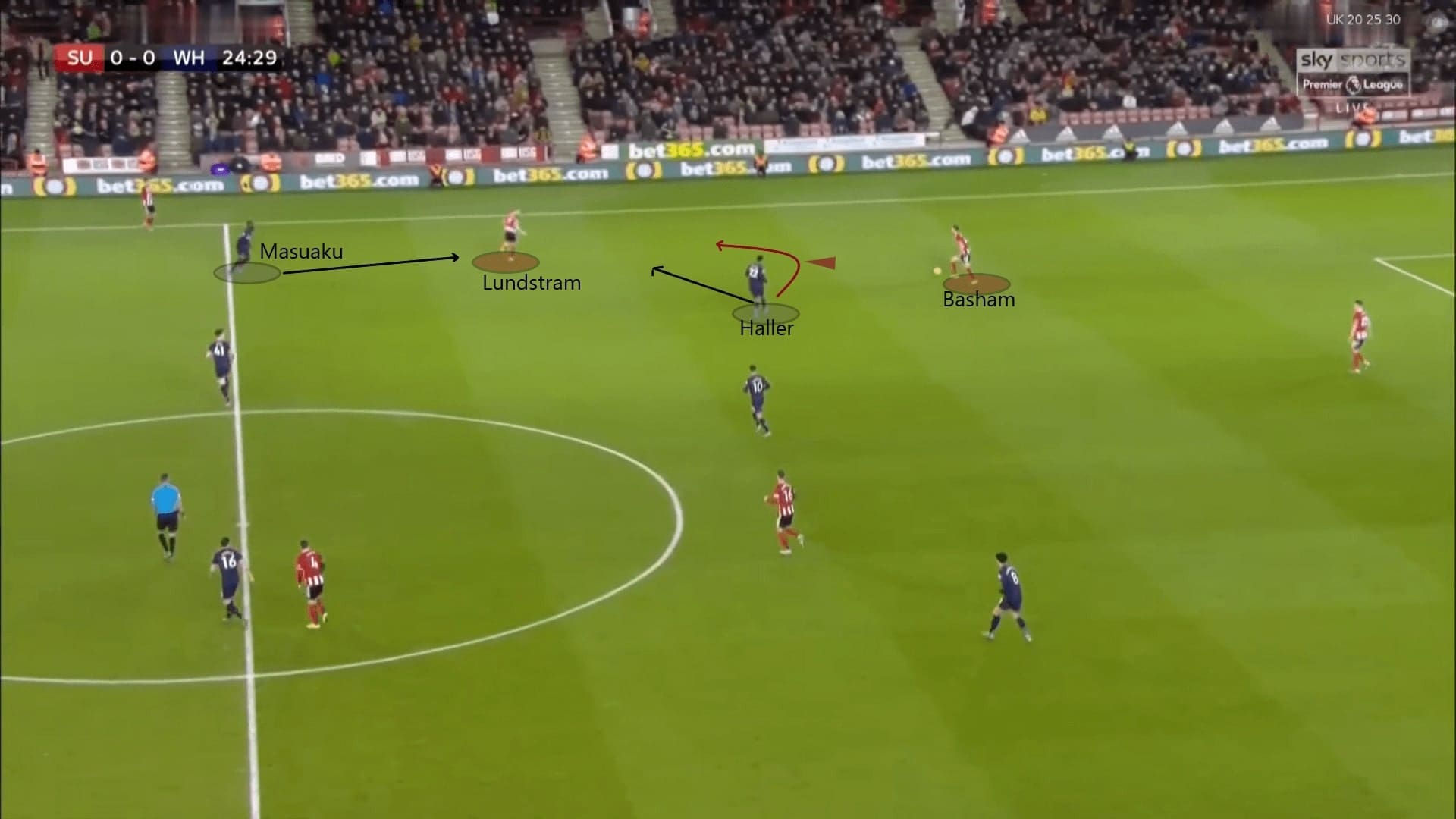
On some occasions, the player closest to the ball did not move, and the wide players came from a deep position to pressure the ball. This would very likely become a useless defensive action, as the moving player was too far away from the ball. The receiver had enough time to react.
In this example, Semi Ajayi received the pass which triggered Lanzini’s (left-winger) pressing. The Argentine was too far away from Ajayi, the centre-back would not panic. The ball was returned to the keeper and switched to another centre-back comfortably.
Another player who did not defend well was Ajeti. In his position, he should have covered the far side while Lanzini was closing Ajayi. However, he was uninterested in following up by pressing the keeper or shutting the passing lane to another centre-back.
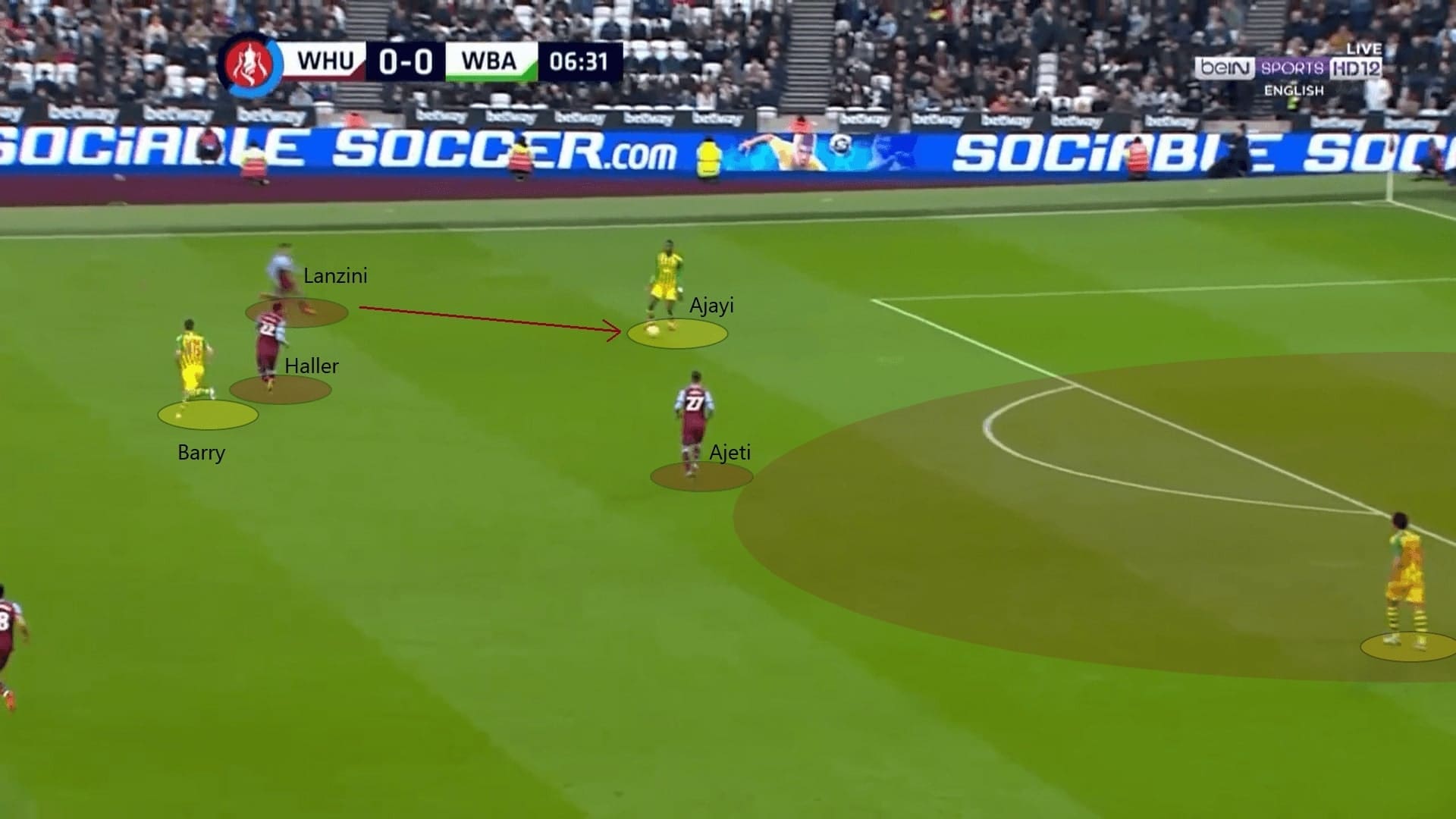
Casualness in one v one situations
Individually, the problem was that West Ham were not defending good enough in one v one situations. Their players were easy to bypass or pressed recklessly. Therefore, even though they were in favourable conditions collectively, they could not win the ball back with the press.
The first example showed how lax Fornals was in this situation. Under this circumstance, West Ham managed to reach numerical superiority on the flank. All of the short options for Dara O’Shea were marked by a West Ham player.
The only option for the Irishman was to carry the ball forward. However, in this one v one situation, Fornals was too casual. The Spaniard came too close to the 20-year-old, and West Brom eliminated the whole press.
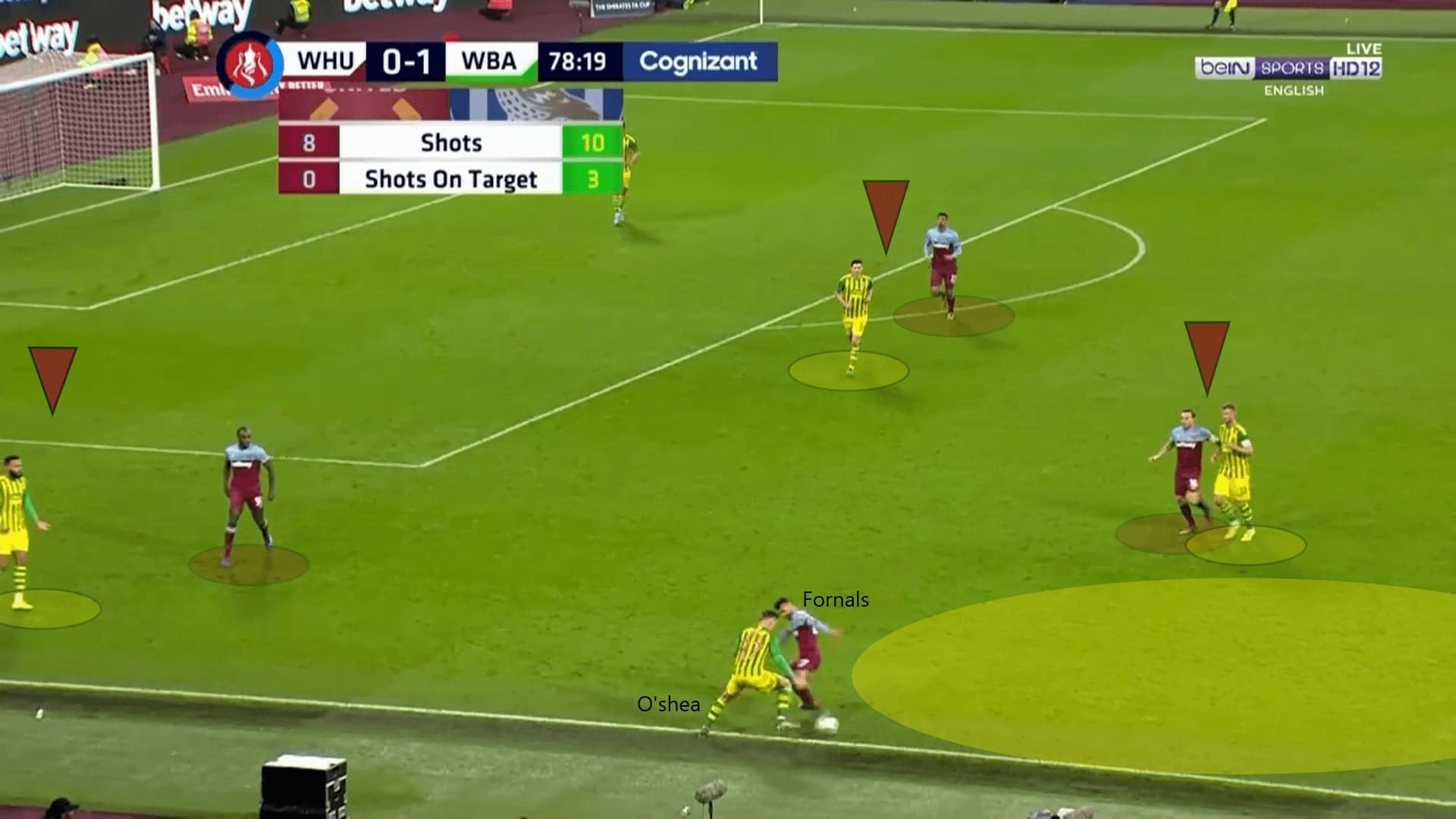
On too many occasions, West Ham players were running directly to the ball. They should have used more curved run, as to shut the passing lane while closing the ball.
In this situation, Masuaku pressed Youri Tielemans alone. He ran directly towards the Belgian as illustrated by the black arrow. However, he neglected the player on the right, Ricardo Pereira. Since Masuaku’s run was direct, Tielemans had time to adjust his body orientation and created a wider angle for a safe pass to Pereira.
In fact, on the far side, West Ham already denied a return pass as they committed three players around the defenders and Wilfred Ndidi.
Meanwhile, Noble was too far away from the area to do anything and cooperate with Masuaku.
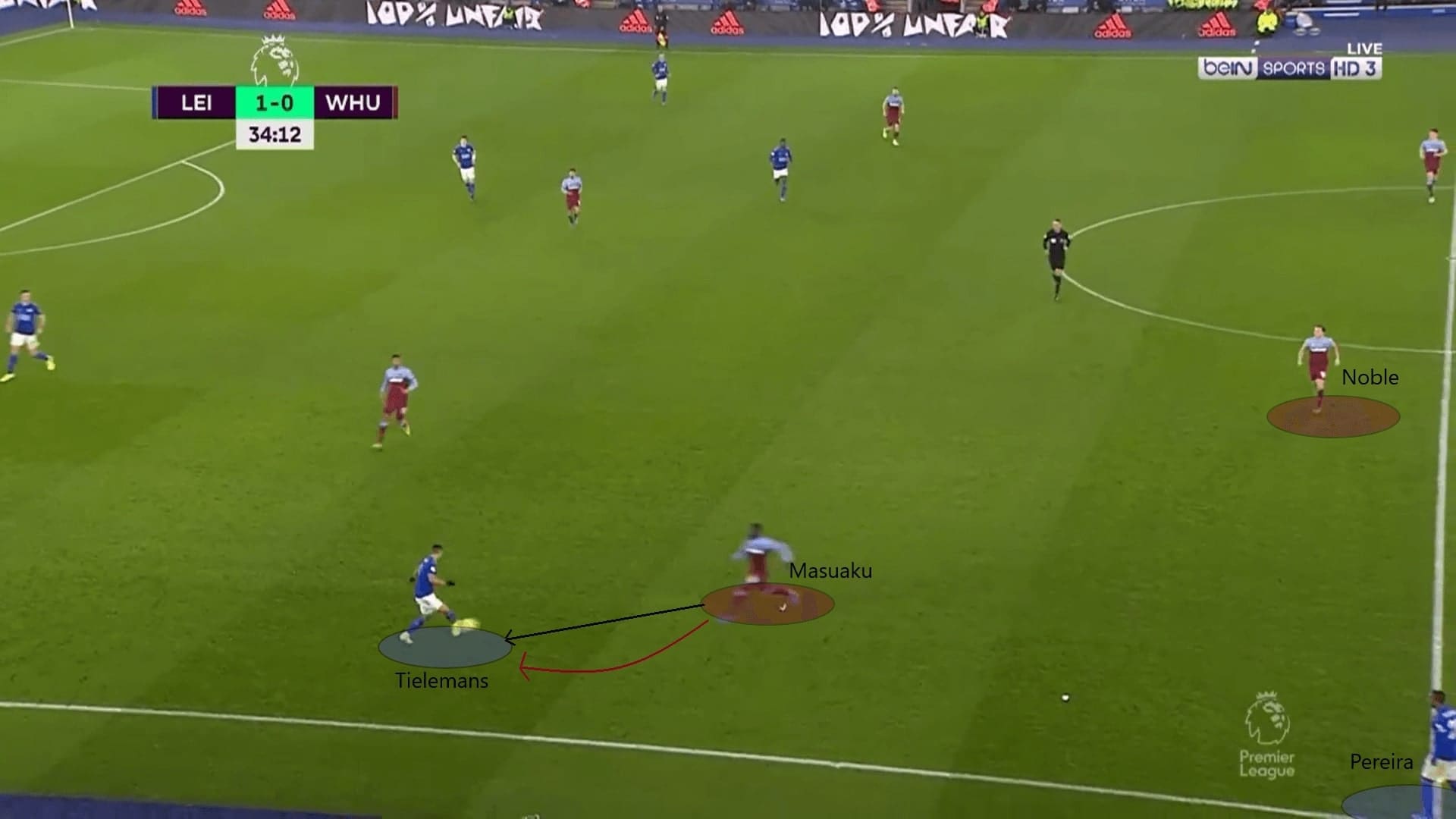
Haller not doing enough
Speaking of individual, we must point to Haller, who did not defend enough as the first man to pressing. The Frenchman seemed to lost the motivations when he first joins the team. Currently, he was reluctant to press. By statistics, Haller only recorded two recoveries in some games recently. While comparing the recovery figure in the early games, it could reach six, seven or even nine.
Haller’s reluctance to press could increase the burden on his teammates. Sometimes, it is conceivable for West Ham players that they could not win the ball as they were overloaded. For example, Haller just let Mason Holgate find Fabian Delph.
Given the rooms in West Ham’s block, Delph could shift the ball to Lucas Digne easily, as Snodgrass was the only player in front of him. It could have been a more balanced situation (two v two) if Haller pressured Delph and Snodgrass took care of Digne.
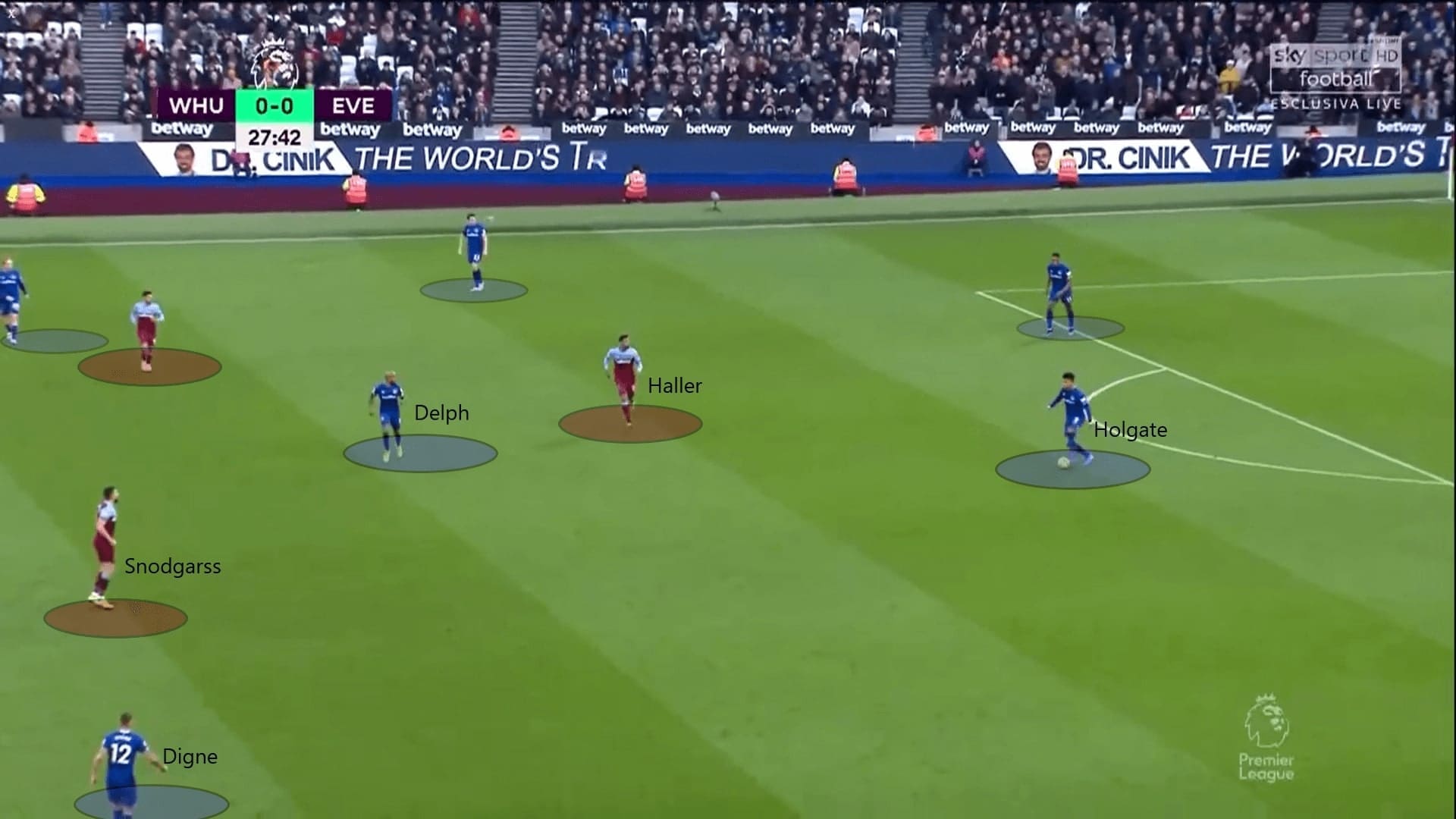
Distances between Noble & Rice
Another issue was the distances between the central midfielders, usually Noble and Rice. When defending, they seldom stick together, instead, Noble would move higher and Rice dropped deeper. However, they failed to replicate the same effects as Rúben Neves and João Moutinho did at Wolves. When comparing Moutinho and Noble, the Portuguese is good at choosing the correct timing to press. For Noble, he pushed himself high too early, which became a pretty visible target to identify.
In the following image, it shows a disadvantage for this type of positioning from Noble and Rice. Noble did not have the same defensive awareness as his partner, and he was not reliable in terms of shutting the passing lanes. When he stepped forward, their opponents were happy to exploit the spaces behind the midfield.
As Tielemans tried to pick James Maddison, the positioning of Noble did not make the pass difficult, as he was far away from Rice. After the Belgian’s pass reached Leicester’s No.10, Noble found himself being eliminated in this attack.
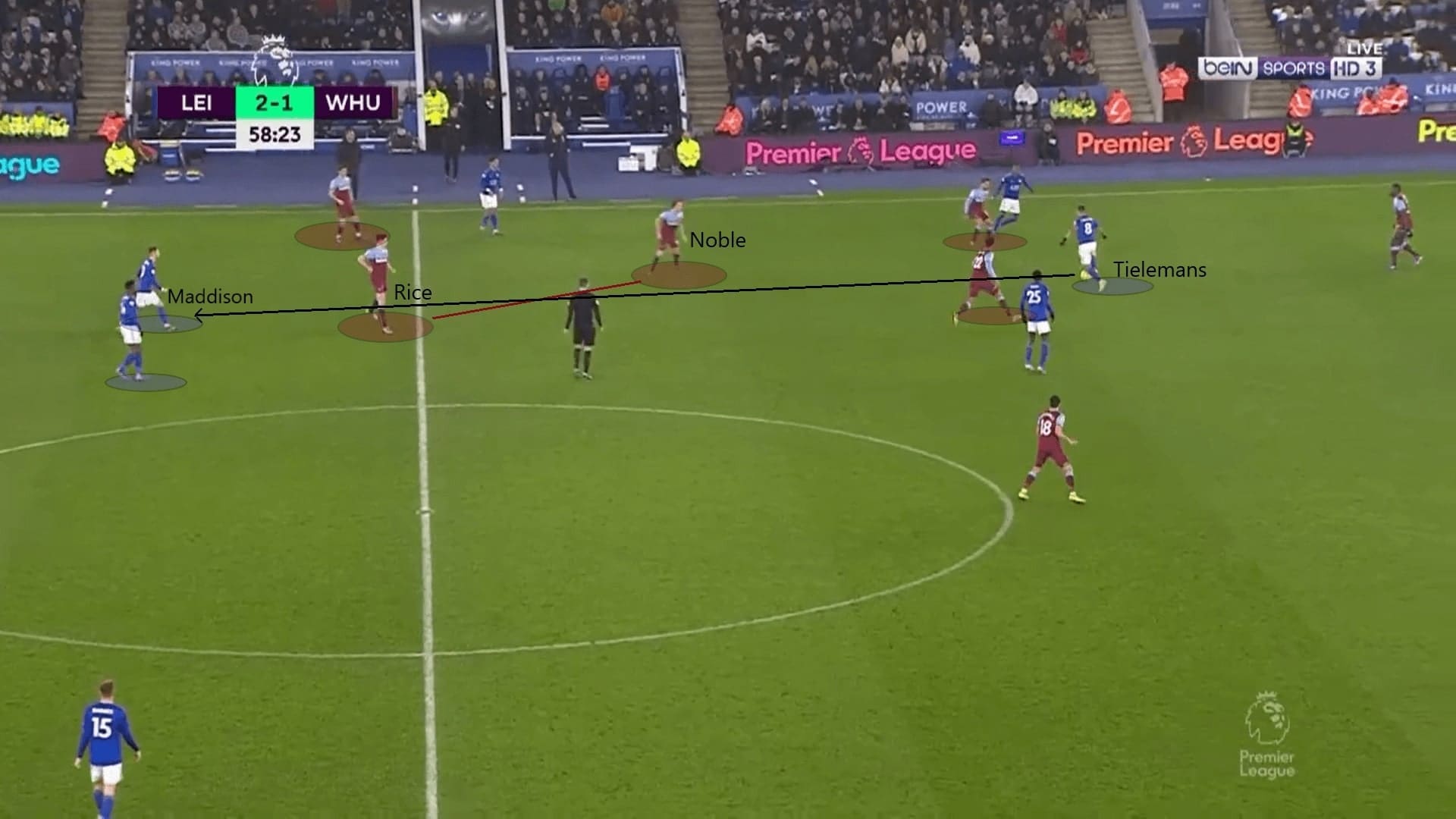
Since the intensity of pressing from the front players was not enough, the positioning of Rice and Noble were vital as they were the last gate to protect the defenders. However, the latter was often eliminated by a penetration pass as he left the passing lanes opened.
In this case, Pröpper easily found Pascal Groß with a vertical pass through Antonio and Noble. This was another example of how Noble’s positioning led to the failure of the press, and allowed the oppositions to exploit the spaces between the lines.
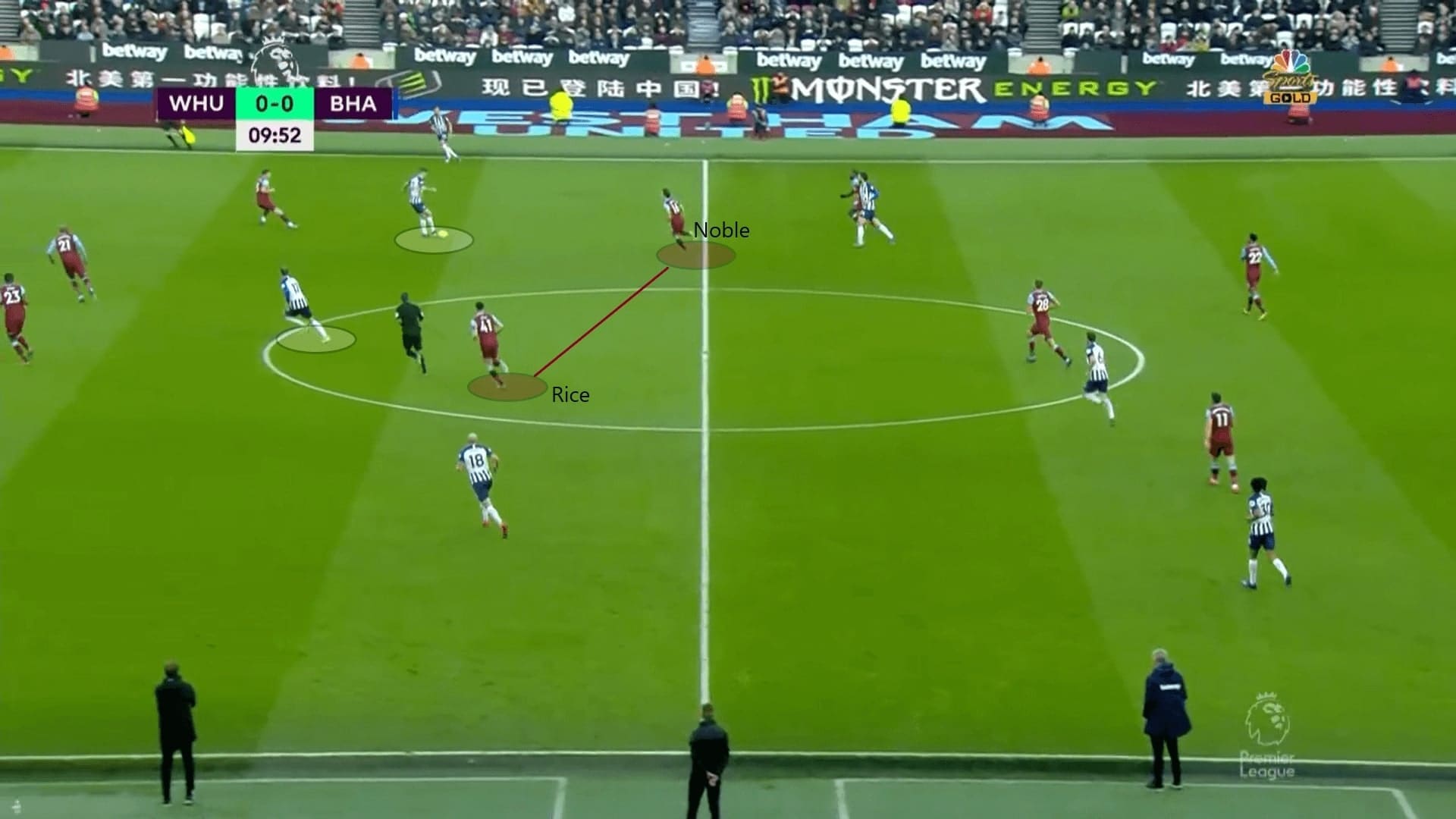
The huge distances between the two midfielders also made West Ham vulnerable when either one pressed, especially Noble. Noble was not as good as players like Ndidi or N’golo Kanté in one v one situations. If the two central midfielders stayed tight, they could cover each other, but the combination between Noble and Rice did not have this effect.
In this image, Oliver McBurnie of Sheffield United dribbled past Noble due to the casual defence of the 32-year-old midfielder. He turned to the spaces in the centre easily, which was generated since Rice was far away from Noble.
It was a dangerous situation as it was a three v three situation for the defenders. Rice was unable to defend against McBurnie as he was too far away from Noble.
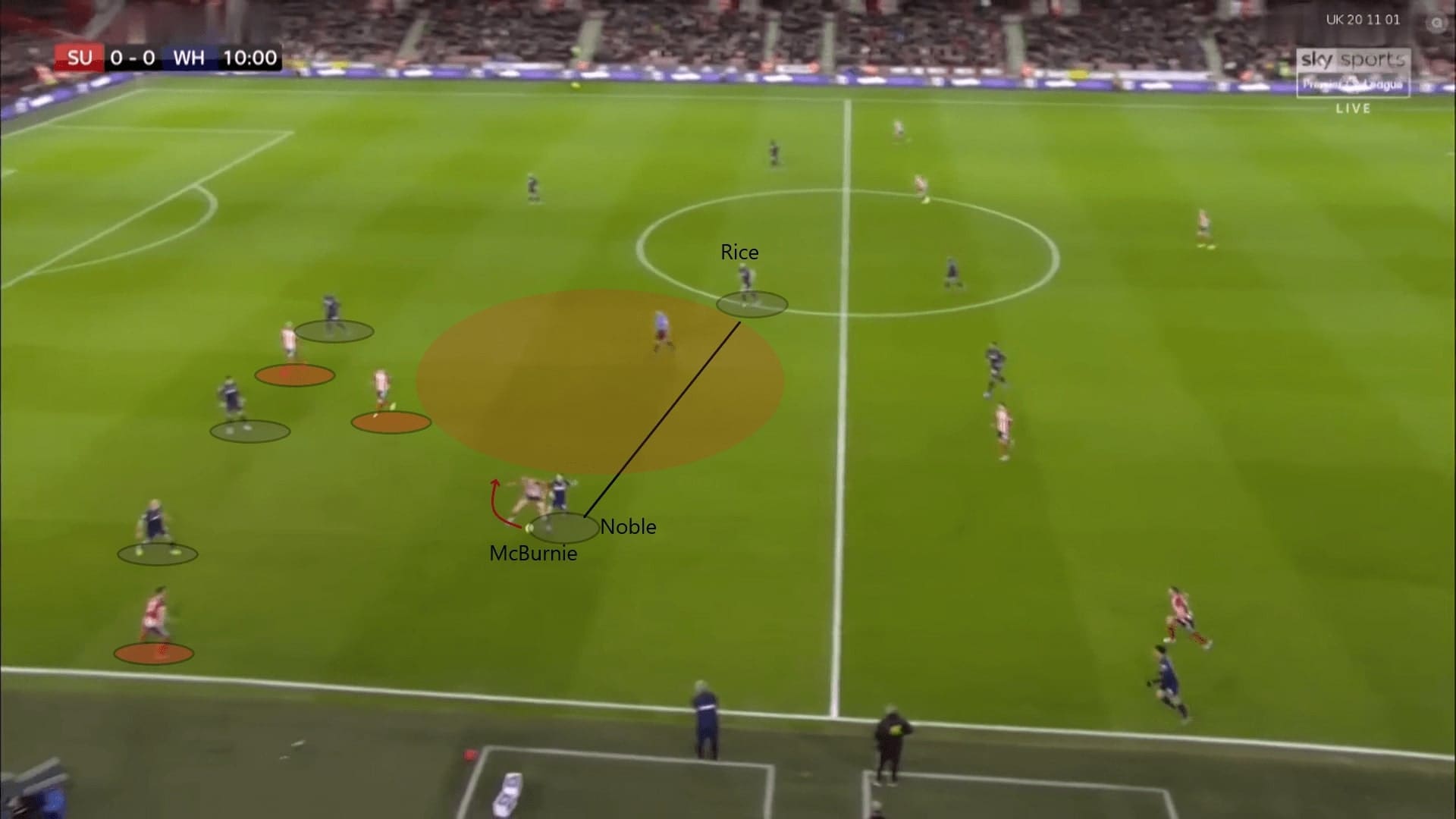
Possible solutions
Sometimes, it could be the structural issues affecting the performance of players. For example, when playing against Leicester, Brendan Rodgers’ team kept using a dropping player as an extra man to overload the midfield. Even though West Ham denied one of the pivots, Noble and Rice were still overloaded.
As shown in the image, when Ayoze Pérez moved to the half-spaces, he created a passing triangle with Tielemans and Maddison. Since the other two pinned Noble and Rice, Pérez could turn freely and further progress the ball.
If the winger tucked inside, then, they could block the central penetration lane and force the ball wide. In this situation, maybe Masuaku could stay in the centre when he noticed Pérez dropped off. If Leicester dared to pass vertically, then they should try to intercept it.
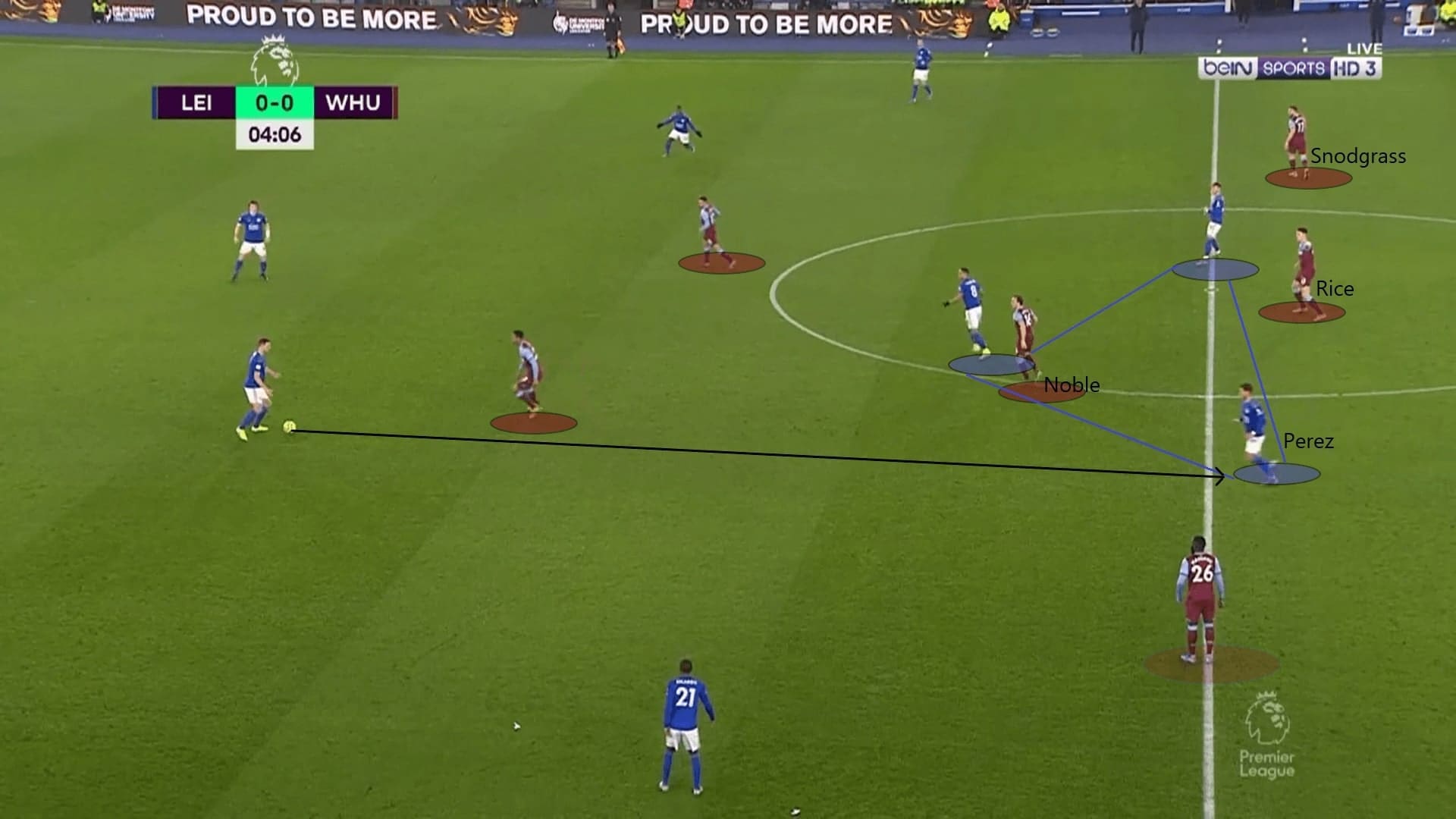
On some occasions, West Ham players should be capable of setting a pressing trap. This could help the team to win the ball high up the pitch, shorten the distance and as a result stop the opposition from creating a turnover. Apart from the new signing, Jarrod Bowen, West Ham lack pacey and skilful wingers like Adama Traoré or Allan Saint-Maximin that can carry the ball forward in these transitions.
The below scenario was a possible situation where West Ham could set a pressing trap. In reality, Felipe Anderson pressed Jack O’Connell as illustrated with the black arrow. It was a very direct run. There were some ways to upgrade the effectiveness of pressing.
First and foremost, they should abandon the direct run, that was visible, as it failed to cover an opposition player. If West Ham merely wanted to delay the build-up, Anderson could take the red route which covers Oliver Norwood while pressing O’Connell. If they were ambitious, then the Brazilian could take the green route, forcing O’Connell to pass forward, intentionally opening up the passing lane to Norwood. Since Haller was around Norwood and the passing distance was not short, the Frenchman was likely to intercept the ball if he used his full speed.
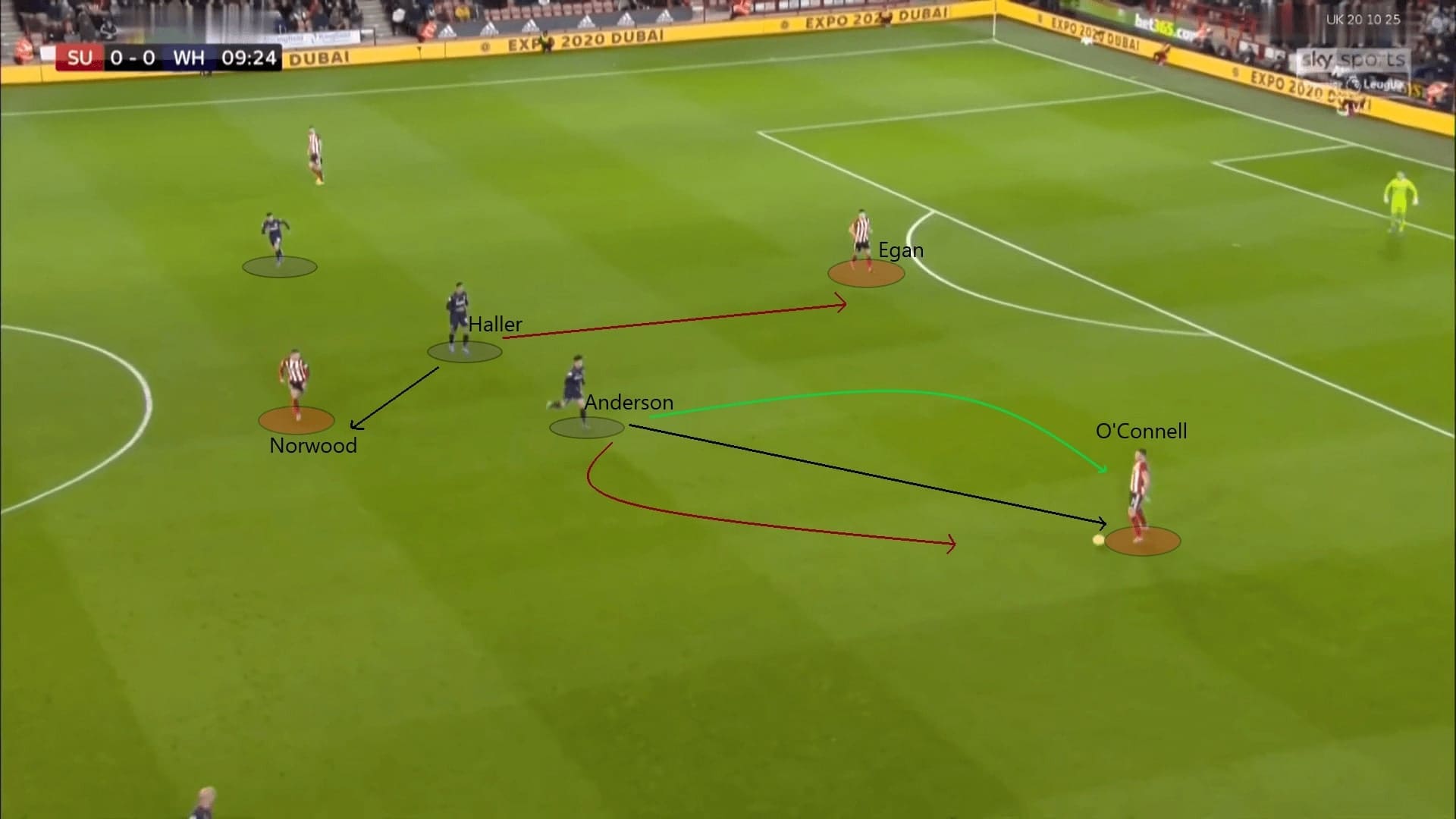
Moyes has tried various formations since his reappointment at West Ham including a 4-1-4-1, 4-4-2, 5-4-1, 5-3-2, 4-4-2, and 3-4-3. We particularly pointed out the intriguing choice of players when the manager played his team with a back three. He used two left-backs in this formation. Cresswell played as the left centre-back and Masuaku played as the left wing-back.
We think this approach could possibly provide the Hammers flexibility when pressing, as they were capable of switching between a back four and three when defending. For example, they could place Masuaku with the three attacking players to pressing up front, with an aim that forces the opponents to play long.
In this phase, they could switch into a back four, as Cresswell was a natural wing-back. Given Ogbonna and Diop’s physical strength, West Ham wouldn’t find themselves in trouble if they could force oppositions to play long. Meanwhile, Noble and Rice could stay between the pressing four and the defenders, serving multiple functions. If the pressing was eliminated and an opponent was carrying the ball forward, they could move forward and press. If the opponents played long, these two could pick the second balls at the midfield.
Of course, the prerequisite of these setups should be based on a compact three lines of defence, and possibly they had to push their defensive higher. With Ryan Fredericks returning from a hamstring strain, he could replace Pablo Zabaleta as the right-back. The West Ham defenders should possess enough pace to hold a higher line of defence.
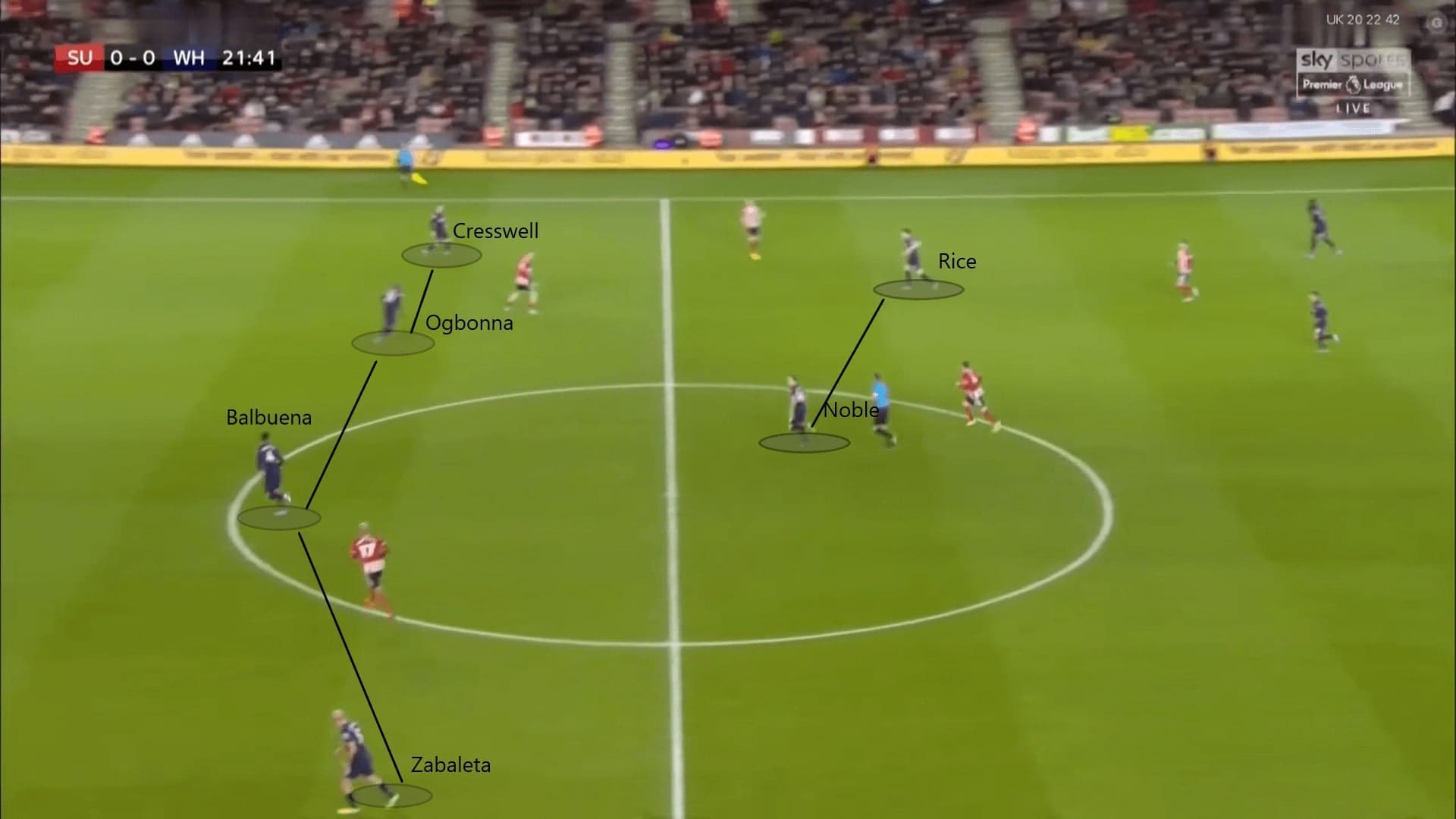
Conclusion
To conclude, it is a difficult situation for Moyes and his team. Defensively, they are one of the weakest teams in the league. They have conceded 43 goals at this stage, only three other teams have conceded more than the Hammers. Of course, Moyes team could totally give up the pressing and defend with a midblock or a low block. However, as we mentioned earlier, this could also affect their counter-attacks as Bowen is the only pacey offensive player in the team.
Pressing, especially pressing high isn’t easy, it requires the concerted efforts of players and hard work on the training ground; it is not only a matter of tactics but also hugely affected by the confidence and motivations of players. The Hammers still have some important games (vs Villa and Norwich) to play in the future which may possibly affect their fate. Moyes has to find a way to balance the pressing and mingle his philosophy with the qualities of players at his disposal.





Comments